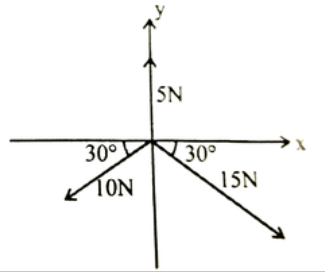Two forces whose magnitudes are in the ratio 3:5 give a resultant of 28N. If the angle of their inclination is 60∘, find the magnitude of each force.
To solve the problem step by step, we will follow the given information and apply the law of cosines to find the magnitudes of the two forces.
Step 1: Define the forces
Let the magnitudes of the two forces be A and B. According to the problem, the ratio of the magnitudes of the forces is 3:5. We can express these forces in terms of a variable x:
- A=3x
- B=5x
Step 2: Write the equation for the resultant
The resultant R of two forces A and B that are inclined at an angle θ is given by the formula:
R=√A2+B2+2ABcosθ
Given that R=28N and θ=60∘, we can substitute A and B into the equation.
Step 3: Substitute the values into the equation
Substituting A and B into the resultant equation:
28=√(3x)2+(5x)2+2(3x)(5x)cos(60∘)
Since cos(60∘)=12, we can simplify the equation:
28=√9x2+25x2+30x2⋅12
28=√9x2+25x2+15x2
28=√49x2
Step 4: Solve for x
Now, we can simplify further:
28=7x
To find x, divide both sides by 7:
x=287=4
Step 5: Calculate the magnitudes of the forces
Now that we have x, we can find the magnitudes of the forces:
- A=3x=3×4=12N
- B=5x=5×4=20N
Final Answer
The magnitudes of the two forces are:
- A=12N
- B=20N
---
Let the magnitudes of the two forces be A and B. According to the problem, the ratio of the magnitudes of the forces is 3:5. We can express these forces in terms of a variable x:
- A=3x
- B=5x
The resultant R of two forces A and B that are inclined at an angle θ is given by the formula:
R=√A2+B2+2ABcosθ
Given that R=28N and θ=60∘, we can substitute A and B into the equation.
Substituting A and B into the resultant equation:
28=√(3x)2+(5x)2+2(3x)(5x)cos(60∘)
Since cos(60∘)=12, we can simplify the equation:
28=√9x2+25x2+30x2⋅12
28=√9x2+25x2+15x2
28=√49x2
Now, we can simplify further:
28=7x
To find x, divide both sides by 7:
x=287=4
Now that we have x, we can find the magnitudes of the forces:
- A=3x=3×4=12N
- B=5x=5×4=20N
The magnitudes of the two forces are:
- A=12N
- B=20N
Topper's Solved these Questions
- VECTORSBOOK - CENGAGE PHYSICS ENGLISHCHAPTER - VECTORSEXERCISE - Exercise 3.1
19 Videos
- VECTORSBOOK - CENGAGE PHYSICS ENGLISHCHAPTER - VECTORSEXERCISE - Exercise 3.2
13 Videos
- TRAVELLING WAVESBOOK - CENGAGE PHYSICS ENGLISHCHAPTER - TRAVELLING WAVESEXERCISE - Integer
9 Videos
- WORK, POWER & ENERGYBOOK - CENGAGE PHYSICS ENGLISHCHAPTER - WORK, POWER & ENERGYEXERCISE - Archives (integer)
4 Videos
Similar Questions
Knowledge Check
Two forces each of magnitude 2N, act at an angle of 60∘. The magnitude of the resultant force
A√1.1 NewtonB√4 NewtonC√12 NewtonD√14.9 Newton
Two forces of magnitudes P and Q are inclined at an angle (θ). The magnitude of their resultant is 3Q. When the inclination is changed to (180∘−θ), the magnitude of the resultant force becomes Q. Find the ratio of the forces.
View SolutionWhen two vectors of magnitudes P and Q are inclined at an angle θ, the magnitudes of their resultant is 2P. When the inclination is changed to 180∘−θ, the magnitudes of the resultant is halved. Find the ratio of P and Q.
View SolutionTwo forces are such that the sum of their magnitudes is 18 N, the resultant is √228 when they are at 120∘. Then the magnitude of the forces are
View SolutionTwo equal forces are acting at a point with an angle 60∘ between them. If the resultant force is equal to 4√3N, the magnitude of each force is
View SolutionTwo forces of magnitude 3N and 4N respectively are acting on a body. Calculate the resultant force if the angle between them is
0∘
View SolutionFind the magnitude of the resultant of shown forces :-

View SolutionTwo equal forces are acting at a point with an angle of 60∘ between them. If the resultant force is equal to 40√3N, The magnitude of each force is :-
View Solution
